Mount Whitney: The East Face
Finding a Little 'Fresh Air' in the California Sierra
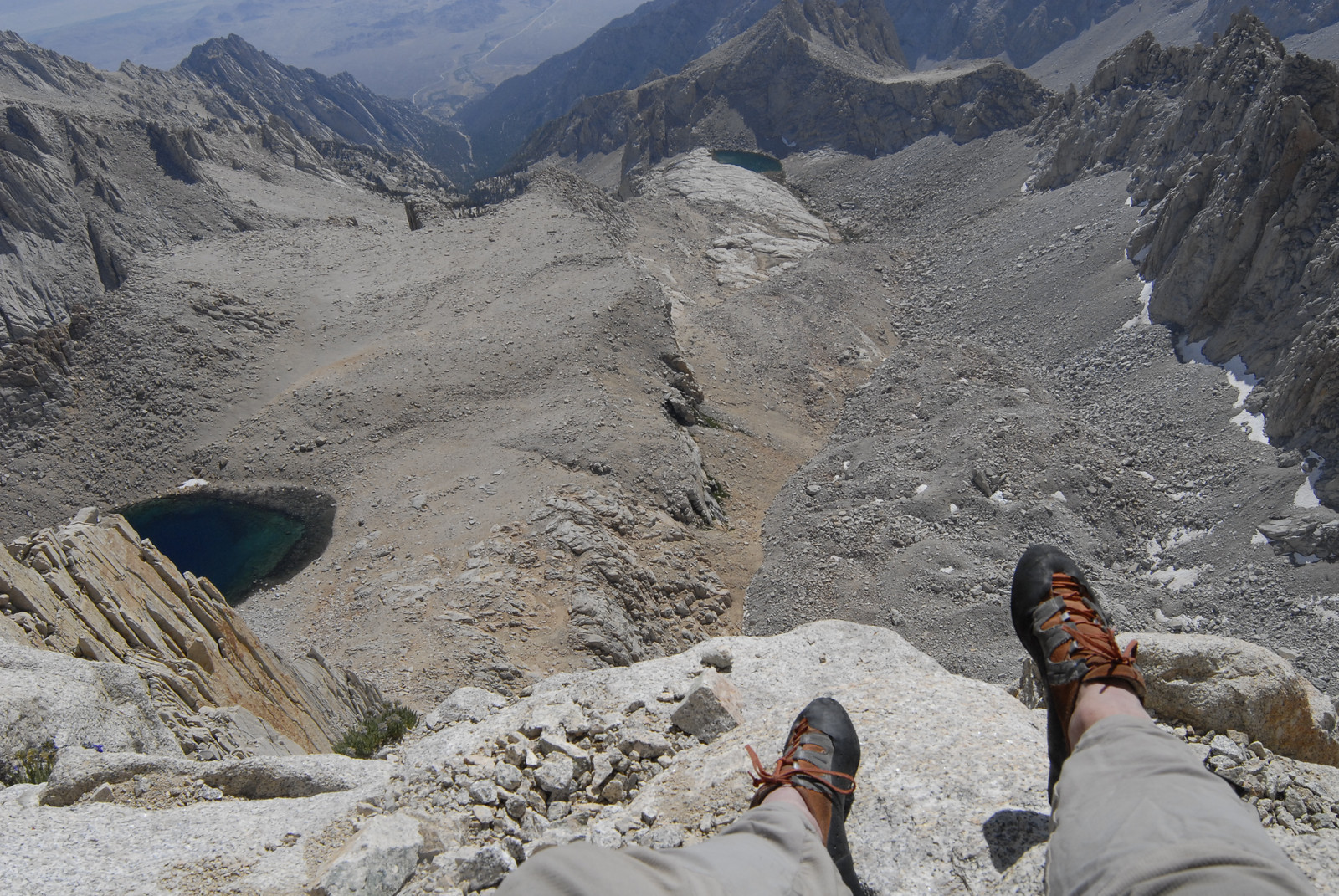
Mount Whitney, California — When I close my eyes, I see granite. Bone-white blocks of rock angle sharply beneath my feet, plunging downward just inches beyond the rubber toes of my climbing shoes.
I press my back against a wall of rock as if I could somehow dissolve myself into it. Everything feels like it's moving—the rock, the air, the fractured granite shelf beneath my feet—all conspiring together, pushing me out toward that incredible void.
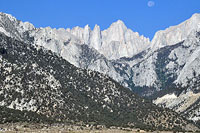
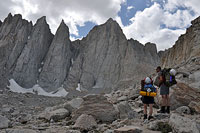
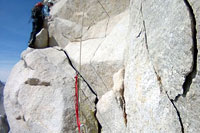
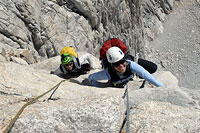
Like most of my schemes, my idea to climb Mount Whitney's east face was born of a curious blend of desire and improbability. Two friends and I had just climbed Whitney for the first time via the Mountaineer's Route.
As we sat breathless upon the summit, worrying about how we were going to get back down, two climbers suddenly materialized from the void to our east and scrambled up alongside us.
They came from the east.
That such a thing was even within the realm of the possible seemed to defy imagination. Just to creep toward the edge of Whitney's east face and look down required courage—if not madness.
Seen from the town of Lone Pine—the postcard view—Mount Whitney's east face appears as a grand and utterly sheer wall of granite, two thousand vertical feet high.
To climb a wall like that was in a league so far beyond my own realm of experience as to seem like a feat of magic.
At that time I did not in the least know anything about technical roped climbing. In fact, our own ascent of the Mountaineer's Route had well and truly terrified me.
Whitney's (allegedly) class 3 north chute had seemed close enough to dead vertical to me. There were moments when I'd just wanted to close my eyes and will myself back home. And yet, I was utterly captivated by the climbers' daring in tackling that immense wall of sheer rock to our east. What would it take, I wondered, to accomplish the same feat myself—to climb Mount Whitney's east face?
That question lodged itself firmly in my imagination over the following years. And time itself was part of the answer: I undertook an apprenticeship of years spent hiking and scrambling in the Sierra, slowly gaining experience and confidence in high country terrain.
This to me is one of the great joys of climbing mountains: you can set any goal for yourself that you choose, and if that vertical dream proves too lofty, you can always find something a little lower, a little closer, a little shorter. Collect enough of those easier routes, however, and a funny thing tends to happen—sometimes those loftier goals come back into range.
Sierra Mountaineering International
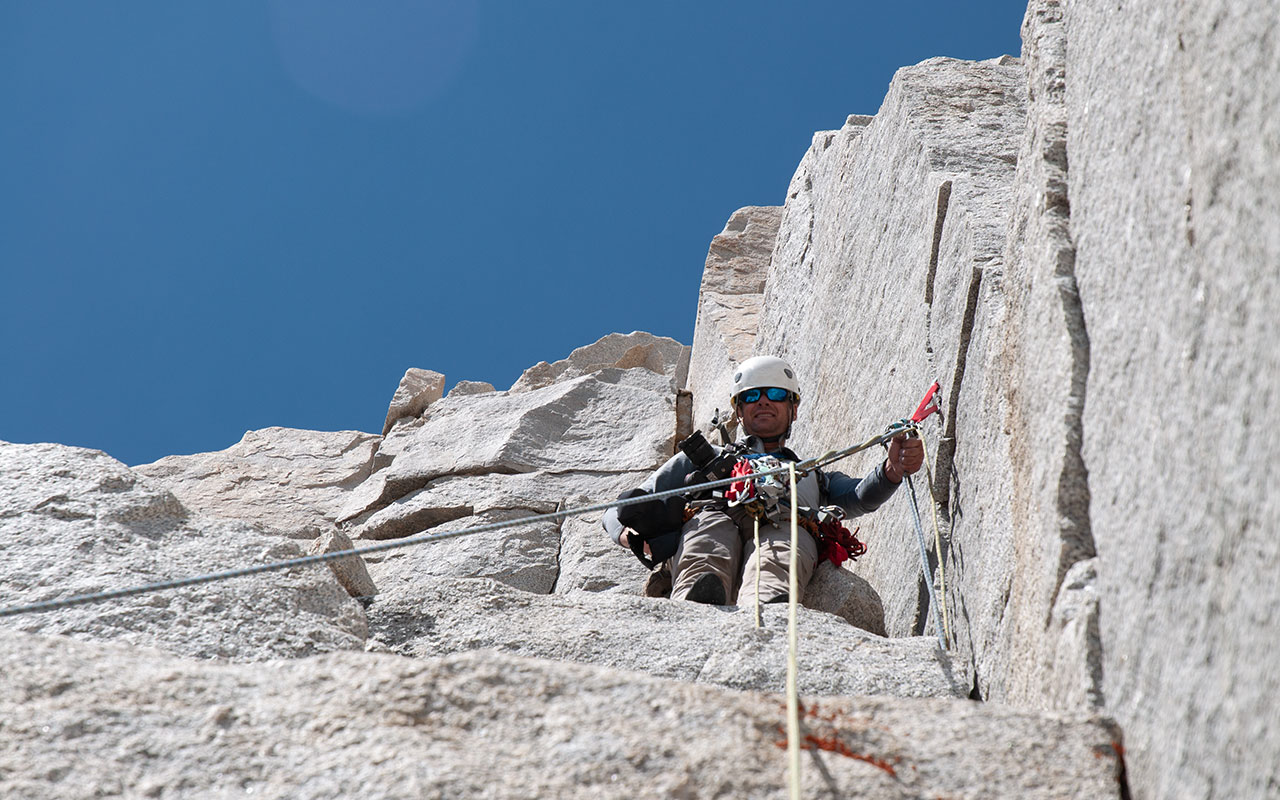
Much of my time in the backcountry I've spent alone, but I've also come to develop a willingness to seek out a little help now and then when I need it. This has proven an especially valuable lesson, often meaning the difference between merely thinking about doing something and actually going out and doing it.
And so I find myself driving north to Lone Pine to meet with guide Kurt Wedberg of Sierra Mountaineering International.
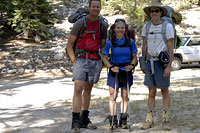

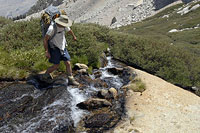
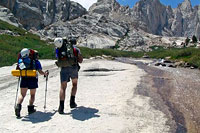
It's time, I've decided, to give the East Face a try.
I first met Kurt while backcountry skiing on Mount Baldy. He was leading a group of climbers on a winter climb on the southeast bowl.
Kurt has the kind of personality where he seems to make friends wherever he goes.
As our two groups recharged outside the San Antonio Ski Hut, he and I got to talking and introduced ourselves.
Founder of his Bishop-based guiding company, Sierra Mountaineering International, Kurt has been guiding professionally since 1986.
Though the Sierra is home base, as his company's name implies, Kurt and his guides climb throughout the world, with an enviable list of major expeditions on their resume.
Kurt also has ties to Southern California, having once lived in West L.A.—my present stomping grounds—and he makes regular forays back down to Southern California to give climbing clinics and expedition presentations—as well as to reconnect with clients and friends.
Our chance meeting in the San Gabriel Mountains made a lasting impression. I knew I was going to want to try Whitney's east face with a guide someday, and Kurt seemed like a natural choice. Now, Kurt and I shake hands outside the Mt. Whitney Cafe in Lone Pine and head in for a pre-trip breakfast. We're joined by the very enthusiastic Eileen, who'll be our third on this adventure.
Eileen has a considerable strike against her in that she's Canadian, but this is largely redeemed by her strong traditional mountaineering skills combined with her relative lack of roped climbing experience, which hopefully means she'll be panicking as least as much as I will.
In addition to climbing, Eileen will also help Kurt and I photograph the route. As a group we are taking a formidable array of still and video cameras to document the climb as fully as possible. And so we are ready—or so I hope.
First Ascent
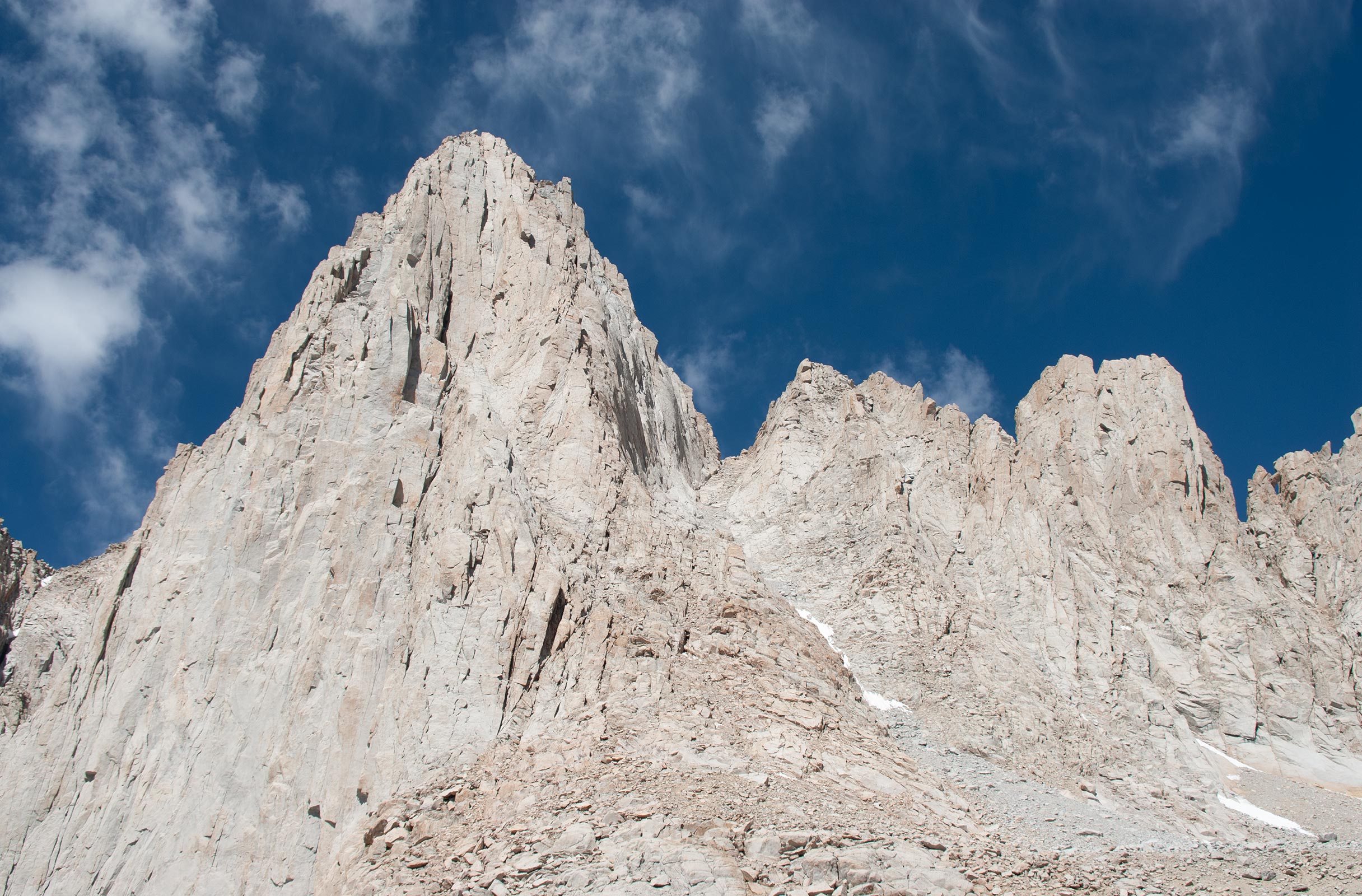
Mount Whitney's east face
The sheer east face of Mount Whitney was considered unclimbable until 1931, when Norman Clyde, Glen Dawson, Jules Eichorn, and Robert Underhill attempted it.
Their group brought together a unique mixture of talents. Clyde was a master at finding viable routes on previously unclimbed faces—especially on big peaks. Youngsters Dawson and Eichorn had the unshakable energy and optimism of youth as well as impressive pure rock climbing ability.
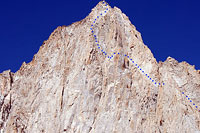
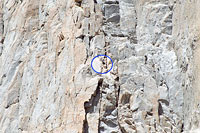
And Underhill, on leave from the Grand Tetons and Canadian Rockies, brought what was then the cutting-edge technique of roped belaying.
The fusion of their respective abilities proved serendipitous.
The four successfully climbed Whitney's East Face, establishing a landmark achievement in the annals of Sierra mountaineering that opened up the range's big peaks to the possibility of technical rock climbing.
While the men had been prepared to be turned back by formidable climbing, in truth the route proved much easier than expected.
As Underhill later wrote, "The beauty of the climb in general lies chiefly in its unexpected possibility, up the apparent precipice, and in the intimate contact it affords with the features that lend Whitney its real impressiveness."
Whitney's east face looks sheer from Lone Pine—yes—but in fact once you start climbing it, quite a bit of previously-hidden texture appears, offering a logical and even moderate way up and across the face. To be sure, there are considerable challenges along the way, including the initial 'Tower Traverse', and then, higher up, the wonderfully evocative 'Fresh Air Traverse.'
But on the whole, Whitney's east face reveals itself to be not just possible but actually enjoyable: a masterpiece of moderate (by today's standards) rock climbing, excellent rock quality, stunning views, and otherworldly exposure.
Apprehensions
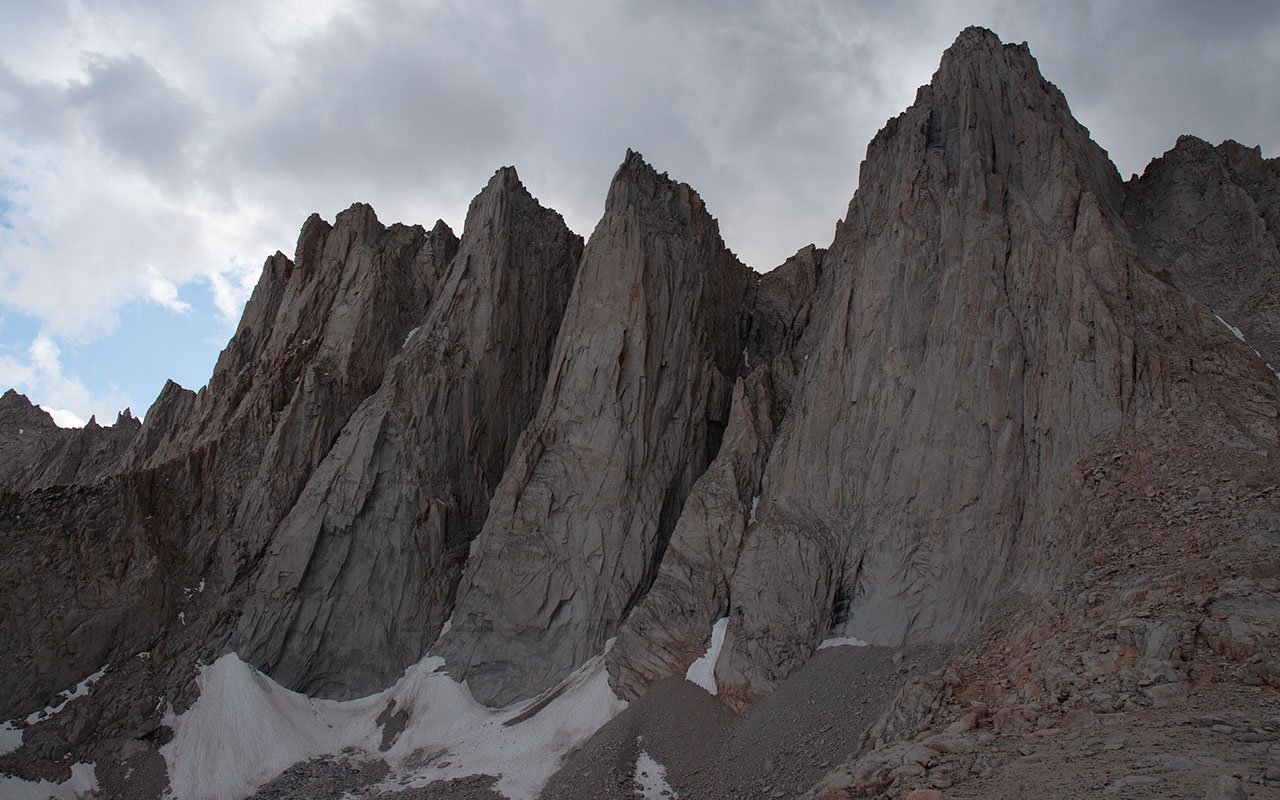
Dark clouds gather about Mount Whitney's 14,500' summit as we reach Iceberg lake. We'll camp here for the night, within striking distance of tomorrow's climbing route.
From Whitney Portal, Kurt, Eileen, and I have enjoyed a leisurely hike up the North Fork approach, following the same trail past Lower and Upper Boy Scout Lakes and then through Whitney's glacial moraines that climbers use to reach the start of the Mountaineer's Route.
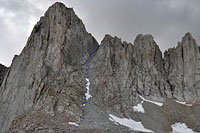
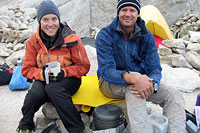
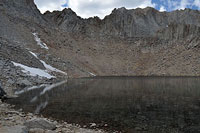
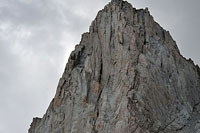
It's still relatively early—not yet four o'clock.
The weather for August seems cool today—though, as its name suggests, Iceberg Lake's 12,600' elevation ensures chilly temperatures year round.
We quickly set up camp. As the heat of the hike up wears off, I don long underwear, a dry shirt, then a fleece jacket and hard shell, eyeing the sky for rain potential.
Rather than just sit around and shiver, I grab my water bottle and my camera and then wander about the lake to take in the view.
Our early arrival has ensured plenty of time to contemplate Whitney's imposing east face.
I admit it: I am a bit of a worrier.
The outcome of any venture in the mountains is always uncertain. Weather often has the final say on a climb's success, but there are many other ways for things to go wrong as well.
I always worry I've forgotten something critical when I'm packing. And, just getting to the mountains from Southern California can be an ordeal in itself. And a last minute cold or stomach bug can end a hike before it begins.
On the subject of illness, no discussion of mountain challenges would be complete without mentioning Whitney's considerable potential for altitude-related ailments. This, is fact, is my number-one concern. Camping at Iceberg Lake puts us in excellent proximity to our climbing route tomorrow, but it also places a lot of strain on my sea level-acclimatized body.
If something is going to go wrong, it will likely happen tonight, as my metabolism and respiration rate naturally cycle down for sleep. Make it through the night in good shape, and I reckon I'll be solid for tomorrow's climbing. But that's still a long stretch of time between now and dawn. I do my best to take deep, regular breaths, and cross my fingers.
And then, of course, there is the elephant in the room: Whitney's east face itself. Taking on this endeavor is a big leap for me in terms of technical rock climbing. I can't help but stare transfixed at that massive wall of rock, trying to imagine my tiny body up there somewhere, clinging to God Knows What.
Yes—I like to push myself. But as the sky begins to darken and the long night settles in, I'm wondering if maybe I've pushed a little bit too far this time.
The Climb Begins
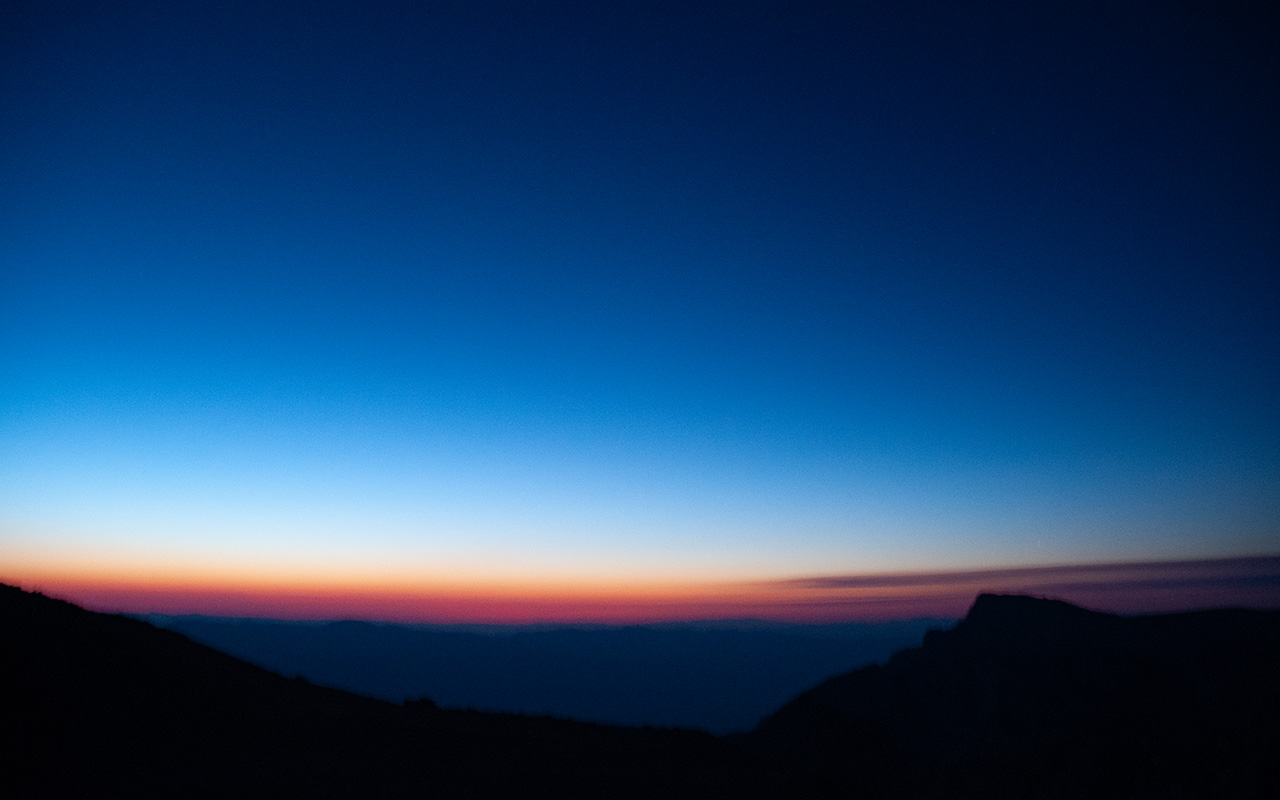
Lone Pine Peak & Sunrise
Kurt's alarm goes off at 4:30 a.m. He fires up his stove, and soon, he's brewing tea and oatmeal, the sounds of which help coax me from my toasty sleeping bag.
The weather is clear and cold, windless. The moon, just past full, casts its light across the rocky talus and dark brooding spires around us. As for me, I've weathered the night in good form. I feel strong, alert, ready to find some rock and start climbing.
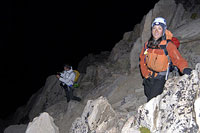
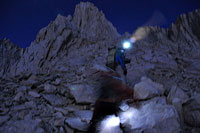
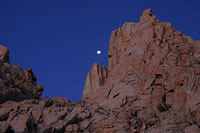
One of the things I love about Summit Day is the sense that your destiny at last lies within your own control. Of course, this may ultimately be an illusion.
Still, the preliminaries of the trip are done, the logistical and scheduling challenges have been met. Now there is only the business of climbing to attend to, and if we are ready for it, there is only the mountain to contend with—and ourselves.
After a bit of last minute packing and repacking, we're all saddled up and ready to go.
The blue-white beams of our headlamps dart and bob on the rocks as we leave Iceberg Lake behind.
We begin by following the lower portion of the Mountaineer's Route, up the East Couloir, but soon Kurt veers southward, leading us toward Whitney's East Buttress.
Behind us, the eastern sky begins its daily magic show. Lone Pine Peak's silhouette rises above Owens Valley like a sentinel. Dawn is coming. I stop now and then, trying try to catch a sliver of this blossoming grandeur with my camera. Meanwhile to the west the moon is about to slip behind Whitney's towering mass, and the rock is just starting to show a hint of pink.
The climbing here in the lower going is just plain fun: scrambling over big blocks of Sierra granite, the angle steadily getting steeper. We're unroped here, but that will soon be changing. We're just about to reach the notch between the two towers that mark the start of the climbing route, about 800 vertical feet above Iceberg Lake (not to be confused with the notch atop the East Couloir).
This is it: the moment of truth. Kurt has timed our arrival perfectly. As we scramble up toward the notch the sun is just about to debut over Owens Valley and the eastern horizon. Only a few final steps remain, and then the real climbing begins.
Tower Traverse
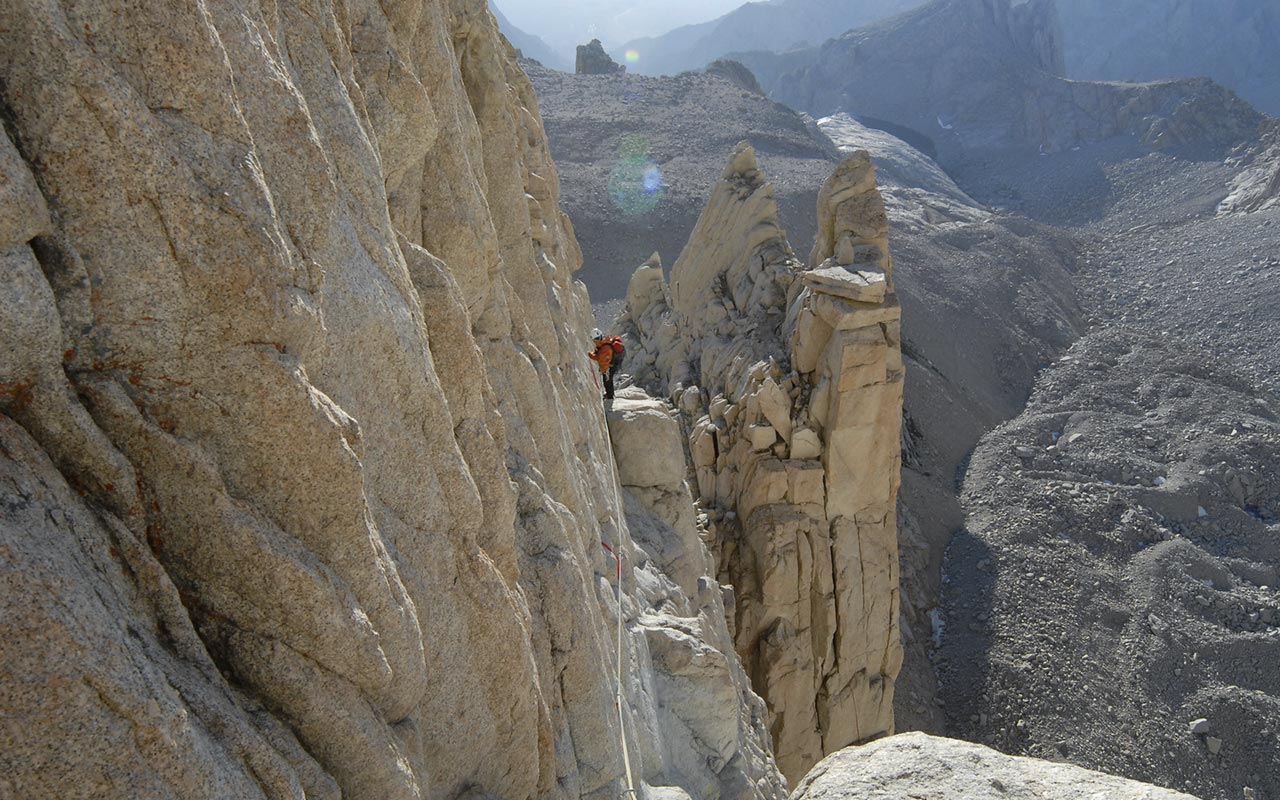
Ooff! That first peek down Whitney's east face gives me a formidable kick to the gizzard. One moment we're happily scampering up blocks of broken granite; the next, we're staring out at space.
If Eileen and I were hoping for a gentle introduction on our first roped pitch, it's not going to happen. The opposite side of the notch offers only a sheer drop of a thousand vertical feet or so to the distant moraines below, where jagged talus now appears as fine grains of sand on a grayish beach.
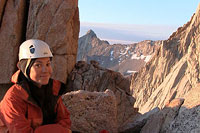
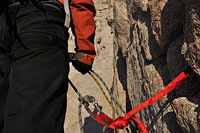

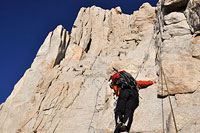
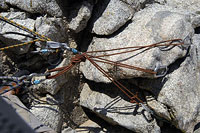
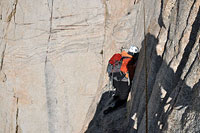
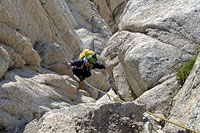
It's instantly obvious here at the notch that this is where the roped climbing begins. Kurt drops his pack and begins assembling the climbing hardware while I fumble around with my harness and climbing shoes, shivering in the suddenly cold breeze that has kicked up.
Pitch one of today's climb begins at the notch and traverses east across tower 2's south wall, which, once again, really does just drop off into empty air.
Beyond the traverse, we'll climb a short chimney to connect with the Washboard, which offers mercifully moderate Class 3 and 4 climbing.
And beyond that...well, maybe we shouldn't let our minds get too far ahead of ourselves right now.
Today we'll be climbing with two ropes, one each for Eileen and me. I try to puzzle out how this will all work when Kurt begins our pre-flight instructions.
Kurt, obviously, will be leading the route, meaning he goes first, dragging both ropes behind him and setting temporary anchors into the rock (nuts, cams, etc) to secure him and us in the event anyone falls.
We will wait in the rear until Kurt reaches a suitable belay location, where he will set up an extra-solid anchor system and then effectively top-rope us: haul in slack while Eileen and I climb up to meet him.
Kurt explains that we can climb in whichever order we please, and even simultaneously, since we'll be on separate ropes. Belaying two climbers simultaneously is an advanced technique, but it offers the considerable advantage of speed—our group doesn't have to wait for Eileen and me to climb each section separately.
As an added bonus, Eileen and I get to stick together through most of the route, offering encouragement or perhaps a few jaunty taunts as one or both of us veers toward freak-out land.
Kurt gives both of us the once-over, deciding our harnesses are too loose and cinching them up accordingly. Then he's off, leading the traverse across a wall of mighty sheer-looking granite, while Eileen belays him from the relative security of the notch, and I snap photos.
Uh...wow. We're really doing this. Somehow I'm remembering all that TV-show advice about not looking down, so my eyes fix on the horizon as if there's nothing at all unusual going on down below. Kurt moves easily across the rock and then disappears from view. Soon, we hear him shout, "Off Belay!" which means he's set the top anchor and is ready for us to switch to climbing mode.
I'm thinking the gentlemanly thing to do here is let the lady go first.
So I wish Eileen good luck and off she goes, moving out onto the traverse. As for me, I'm not far behind, stepping onto a narrow but doable ledge and shuffling gingerly across. The 5.4-rated Tower Traverse offers solid footing for the most part, but the tricky bit is the really slim pickings in the handhold department.
I've got my still camera in a case on my chest, which compromises my ability to keep my center of gravity close to the rock, and suddenly right here on pitch one I'm having an authentic Oh Shit! moment as the reality of where I am hits. No thanks Reality—I make a quick detour from those thoughts, distracting myself momentarily by watching Eileen.
All right—she's across. I scrape and slide my body along the wall, finding (just) the right places to stick my feet, clawing smooth rock here and there with my fingers, and then I'm across also. Yep. We're in for it. I dimly wish we've already passed the crux of the route, but I know harder climbing undoubtedly waits for us above—lots of it.
The Washboard
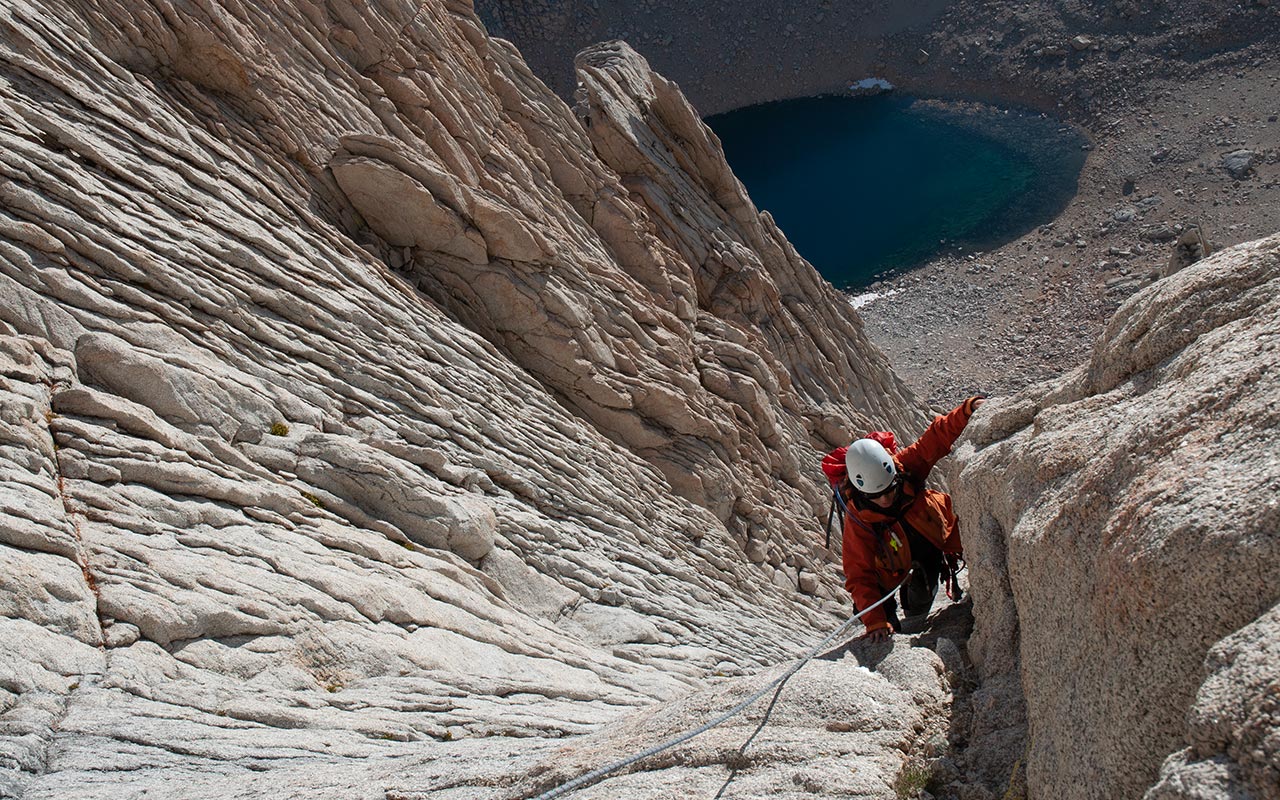
A bit of steep but otherwise moderate chimney climbing gets us to our waiting leader, Kurt, and The Washboard, a prominent ramp-like feature leading up Whitney's east face.
When Eileen and I reach Kurt at the belay station, we get a mild scolding: our pace up pitch one (in rock climbing, a 'pitch' equals one rope length, typically sixty meters) has been a little too pokey for comfort, given that ten more pitches of climbing remain.
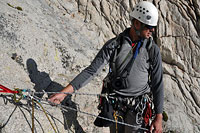
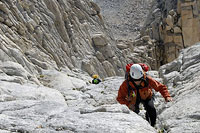
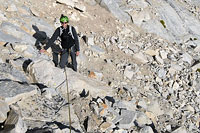
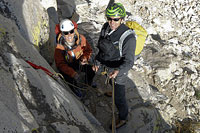
Kurt doesn't want us to climb faster, but he does want us to work on our belay transitions, which he says tend to chew up a lot of time if you're not careful.
He gives us a few efficiency-boosting tips, and then he's off again, starting up the Washboard while we wait for him to secure the route.
As Kurt climbs, Eileen and I man the belay, feeding him slack while also comparing notes on our respective Pitch One experiences. Consensus: there were some tricky bits back there that took both of us by surprise.
Still, the sun is shining, the view is breathtaking, and our excitement at just being here on this extraordinary route is more than enough to keep our spirits high.
The Washboard does offer a bit of a mental respite from the Tower Traverse's initial exposure shock.
Here, the biggest challenge is keeping pebbles out of your climbing shoes while spectacular vistas unfold around you.
Our group makes quick work of this section, moving easily up the Washboard's uneven ground. In fact, the terrain is moderate enough to make us forget where we are.
Given the east face's apparent sheerness as seen from Lone Pine, it's hard to imagine how much texture the face actually has. This, as Robert Underhill noted, does indeed add to the richness of the route. What looks from below like impassible granite proves up close to offer many possibilities—some of which, like our present position, offer quite modest climbing.
But don't get too comfortable. The Washboard soon ends in a striking wall of rock called the Alcove, where further progress upward is not possible (at least, not for climbers of our ability level). This same section gave the first ascent team pause as well. To get past it, we'll traverse yet again across Whitney's great eastern face, and this time where exposure is concerned, we'll be getting the full dosage.
The Alcove
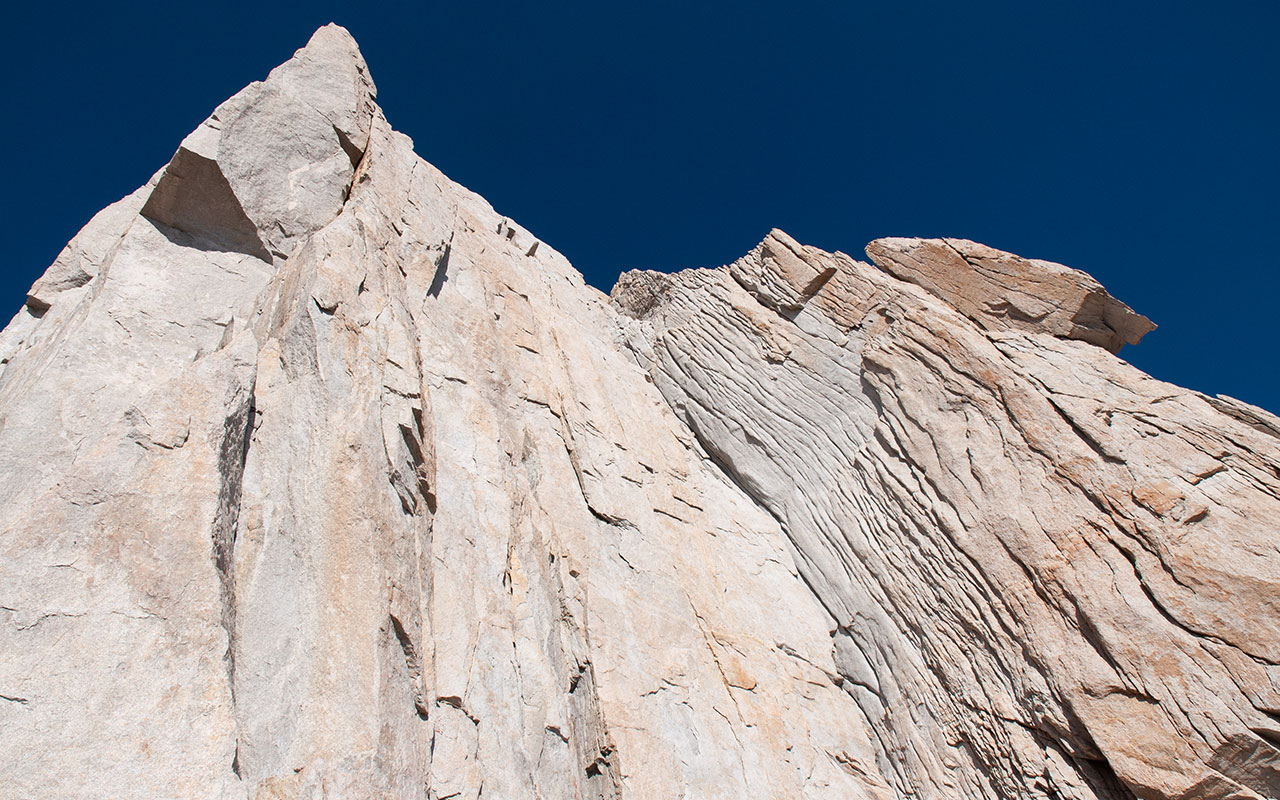
Primal fear has been occupying much of my attention, but have I mentioned the patterns in the rock? Each section of our climb thus far has its own patterns and textures, like paintbrush strokes on a master's canvas.
These differing shapes make for unique climbing in each segment, as if we are on not one but many different Alpine routes. The Alcove is certainly one such remarkable feature: a high altitude amphitheater that exists for your concert-going pleasure at just under fourteen thousand feet in elevation.
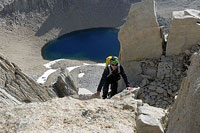
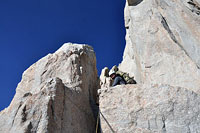
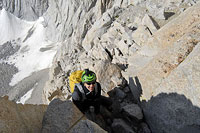
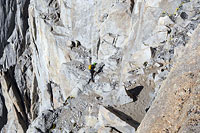
To escape the Washboard and the dead-end Alcove above, we climb now toward another notch between the east face and a small tower. From there, we'll down-climb a short section and take a break on the opposite side overlooking the start of the Fresh Air Traverse.
I get to go first on the down-climb, which affords me the right (I believe) to claim I got to lead one bit of the climb—even if it was butt-first.
On the other side of this small notch is yet another east face surprise: a broad, sandy ledge that under other circumstances would make a fine place for camping. Eileen is next on the down-climb section, and then Kurt, and soon we're taking our mid-morning break.
This classic hanging ledge offers stunning eastward views of Mount Whitney's north fork drainage and Owens Valley beyond.
But in truth my thoughts keep turning rightward, to the rock work that lies next on our agenda.
The evocatively-named Fresh Air Traverse is one of those mountaineering classics steeped in both history and impact. For me personally, it also represents a (hopefully figurative!) leap into the unknown. I don't really know how I'll react to it.
Norman Clyde's description (in Close Ups of the High Sierra) is not particularly reassuring: "The Traverse proved to be one requiring considerable steadiness, as these ledges were narrow and there was a thousand feet of nothing below them. As we came around the projection we were confronted by a gap in a ledge with a narrow platform about eight feet below. There was the alternative of stepping across it—as far as a man of medium high could possibly reach, availing himself of rather poor hand-holds—or dropping down to the platform and climbing the other side of the gap."
That sentence has lingered in my memory ever since I first read it. I've imagined myself confronting that same gap, wondering what I'll find. Will I be able to get across? What will the sight of so much airy nothing below my feet do to my mind? Saner adventurers might well do a better job preparing themselves for a moment like this—say, by taking climbing classes, apprenticing on easier but still technical routes—but here we are, and there is nowhere for us to go now but onward, toward whatever awaits us.
The Fresh Air Traverse
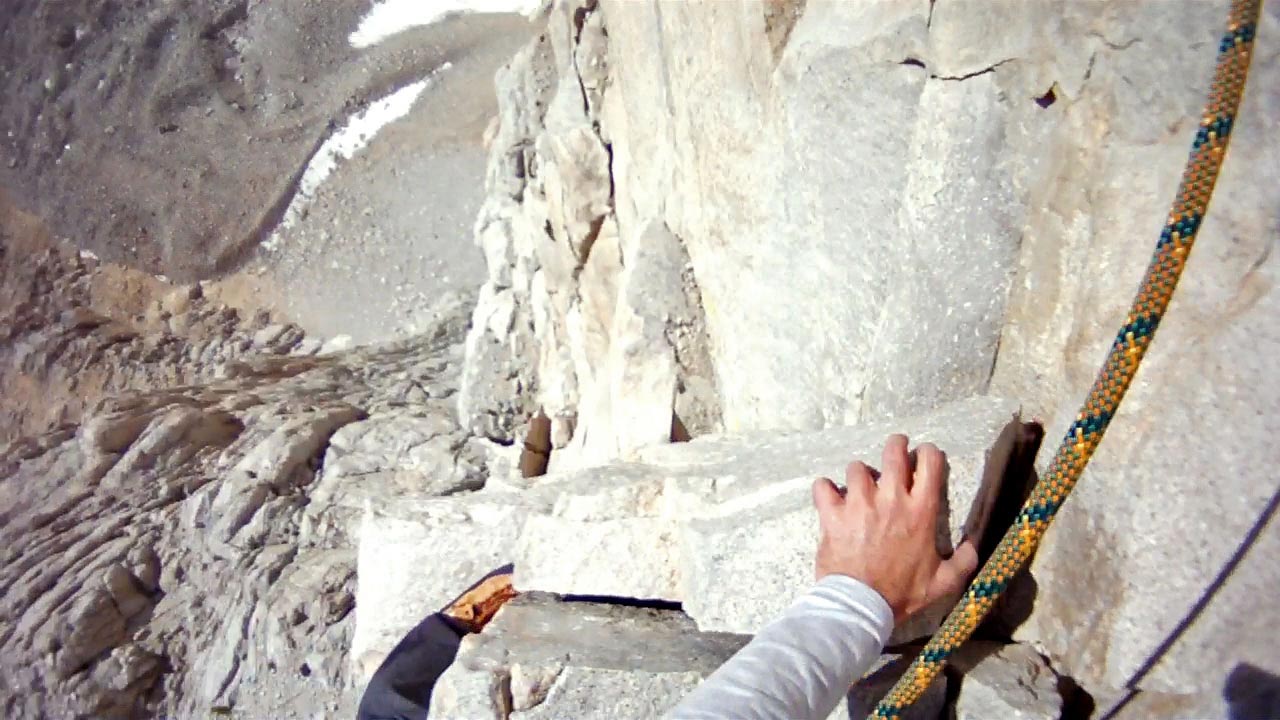
From our comfortable perch atop the relative safety of the sandy ledge, we advance westward into a rocky corner, where a grinning Kurt sets up the next belay.
That done, Kurt begins leading the next pitch. He is around the corner and out of view in moments...and then, for the first time on our climb, Eileen and I suddenly hear Kurt shouting. No, these are not shouts of trouble, they are whoops of delight coming from our leader as he climbs the most famous pitch on the route.
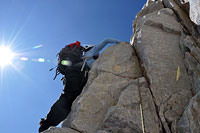
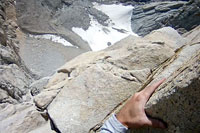
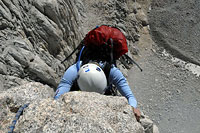
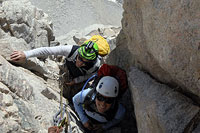
The combination of our limited field of view plus Kurt's enthusiastic yells echoing about make for an interesting effect on my already-buzzing psyche. "Off Belay!" shouts Kurt, and now Oh Boy it's our turn to follow.
Eileen goes first. Like Kurt, she quickly climbs out of view, scrambling up and around a pillar of granite. After I clear and rack the gear at the belay station, I'm right behind her.
If you were going to design the perfect pitch, I think you'd be hard pressed to do better than this: the Fresh Air Traverse starts out deceptively, tucking you into that corner of rock so that you're well protected from any potentially disturbing view.
Scramble up the pillar a bit—just ten or twenty feet or so—and then you creep along a little ledge around that little corner, no problem at all, and...Shazam!
Are those really my feet standing on that tiny ledge over all that...space? The view is so wildly skewed, so utterly out of order, it's hard to take it seriously, as if it can't possibly be real.
Welcome to the void.
As if on cue, a sudden wind kicks up, causing the anchors ahead to clank gently against the granite wall. Even as I feel myself slipping off to my happy place, I've got to admit: this is a masterpiece.
That said, Don't Look Down is proving kind of difficult. For one thing, that little ledge is about all there is to stand on right now. For another, there is unquestionably a hypnotic pull to that void.
I'm not going to go so far as to say it is calling to me, exactly, but there does seem to be some sort of a message out there, and I'm not sure listening to it right now would be such a good idea.
I find the best course of action is to temporarily disconnect whichever part of my brain is responsible for processing gravity.
Slow, cautious steps take me to Norman Clyde's famous gap in the ledge, which does indeed look formidable. Hmm. Eileen has successfully passed this point, which is good, but now she's gotten tangled up with my rope ahead, which leaves me perched right at the edge of the gap with a whole lot of time to do nothing but hang tight while she works to clear the snarl.
Spare time for my mind to start thinking about things proves less than ideal at this particular moment. I stare at the gap as if it were some sort of puzzle. How the heck am I going to get across that thing, I wonder? Honestly, I don't see any easy way across. I'm not even sure if I see a hard way across, which feeds nicely into thought #2: how exactly did I get here, again?
Eileen is free and moving once more, which means it's finally my turn. And then a most unexpected thing happens—a sequence of moves suddenly flashes into my head, and without thinking I grab the rock and move cleanly and easily across the gap in one smooth motion, as if the solution had just been beamed into my head. Awesome! Mortal terror notwithstanding, I break into a full grin and even find the moxie to shout up to Kurt, "Hey, when do I get my Fresh Air??"
The Grand Staircase
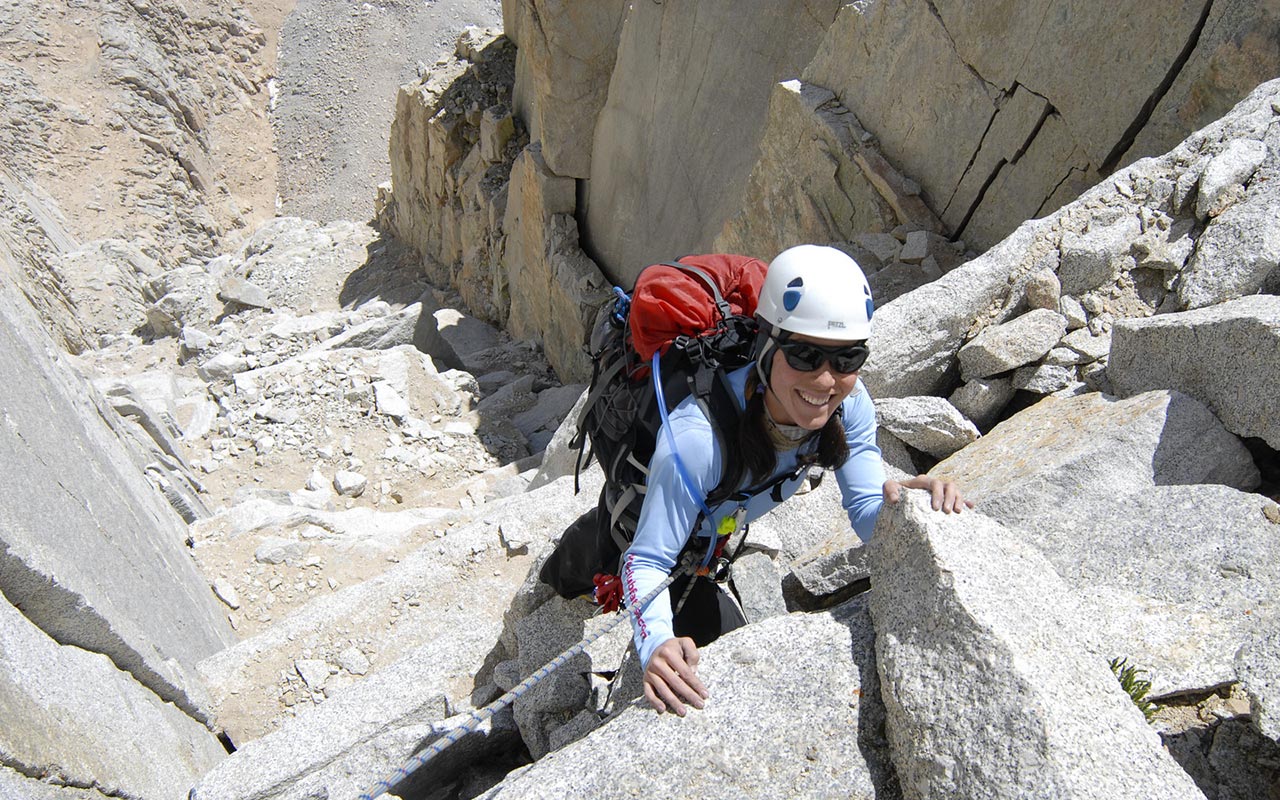
Elation wears off a bit above the Fresh Air Traverse, where the next pitch proves (for me, at least) to be the most challenging and nerve-wracking of the entire climb.
I am learning a lot about myself as a rock climber on this adventure. First of all, if it's not obvious, I'm no expert. But I do notice I have a bit of a knack for certain sorts of problems—my mind and body seem to click on these moves, especially where good handholds and inventive shifts in balance are involved.
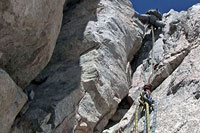
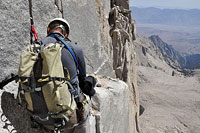
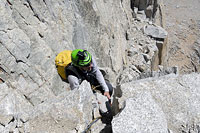
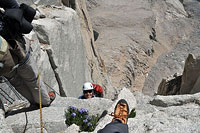

I am also experimenting with my climbing shoes, trying to discover just how small a hold or nub of rock I can step on and still find enough friction to call it solid.
But, especially where handholds are poor, my technique stiffens, and I rely on brute strength and awkward movements.
This next pitch seems to contain a lot of that.
We're trying to connect to the more moderate grounds of the Grand Staircase, a giant ramp leading directly up the mountain.
But first we have to get there.
At one point, Eileen and I diverge following opposite sides of a gap up the mountain. Things get sticky for both of us at the same time.
We look across at each other helplessly, both wishing we could swap places, but there is no easy way out here, just hard, nail-biting climbing.
It is therefore a big relief when we top out the pitch and arrive at the Staircase.
Once you learn to look for it, the Grand (or Great; also Giant) Staircase is one of the east face's most distinctive features, easily visible from below.
Here, we find granite ledges neatly arranged in what does indeed resemble a giant staircase.
Importantly from my point of view, that gnawing sense of exposure mitigates here, allowing me the ability to relax a bit and enjoy the views.
Our arrival at the Grand Staircase heralds an important milestone: we're now well past the midway point on our climb, and aside from a tricky move here or there, we're also past what I consider the hardest climbing.
As much as I've enjoyed the constant buzz of exposure and rock over the past few hours, I am feeling ready to top this one out and stand on some solid ground. The Staircase obliges. We make good progress here, climbing smoothly and efficiently. And we are certainly getting higher up the mountain as well, opening up new vistas. To the south, we can now see Olancha Peak, Mount Langley, and Mount McAdie on the horizon, as well as the much closer spires of the Needles and Crooks Peak.
Each pitch of this sprawling route continues to offer new challenges and new vistas, and the Grand Staircase proves to be one of my favorite sections of the climb. And there is one last surprise for us: a tricky little traverse around a rocky edge with plenty of exposure to keep things spicy. But around the corner we go, old pros now, and only a short stretch of scrambling separates us from Whitney's 14,500-foot summit.
Summit Blocks
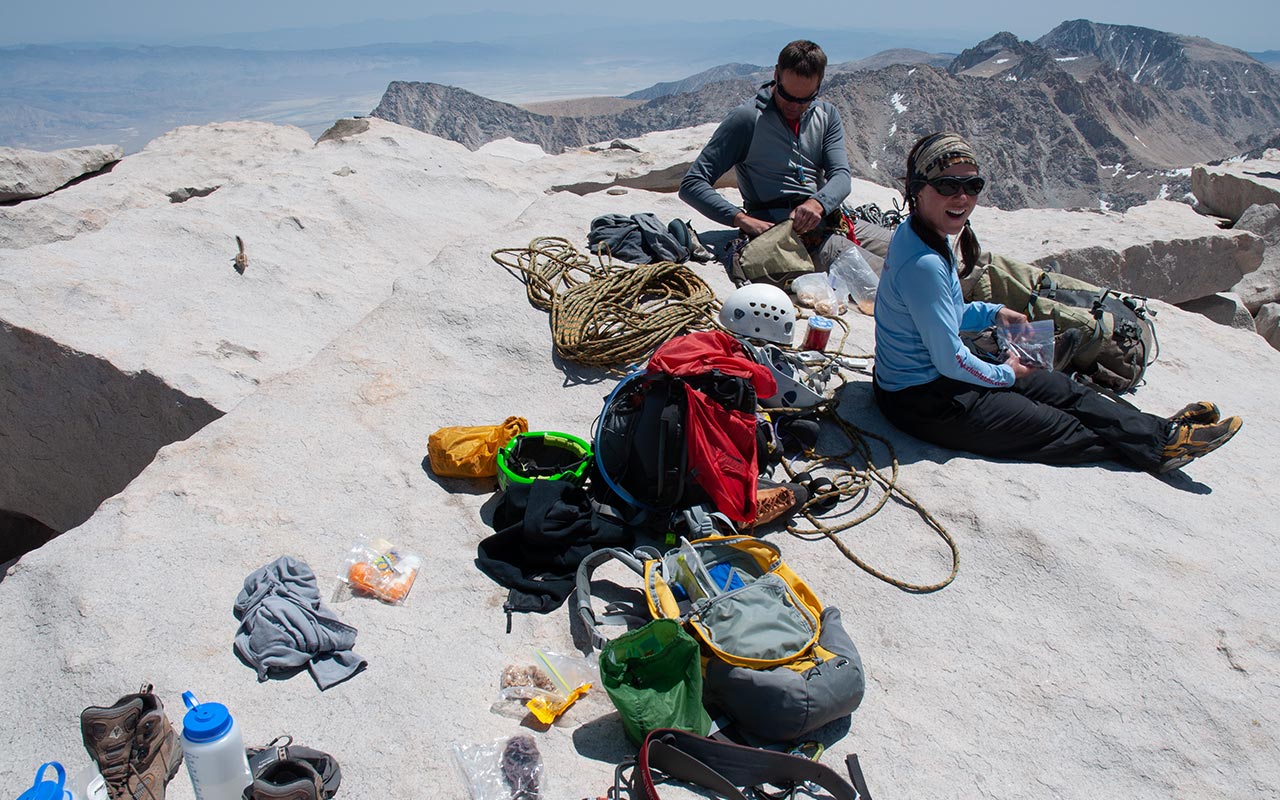
For the final 'pitch', we remain roped together but no longer stop to set fixed belays. Instead, we climb simultaneously, using the rope for extra security only where needed.
The upper segment of climb features mostly Class 3 work over large blocks of broken granite, with the occasional sticky spot or exposure shot that makes staying on the rope a good idea. At such locations, Kurt goes first, and then wraps the rope around a rock flake to improvise a belay when we follow.
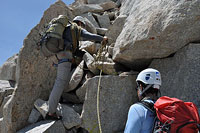
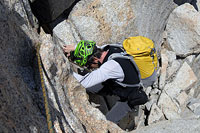
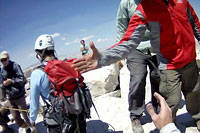
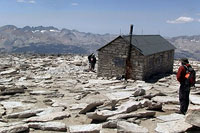
Looking north, I realize we've joined the top of the East Buttress route.
We've got a bird's eye view of Mount Whitney's East Couloir, and Mount Russell beyond.
I'm focusing on my feet and views downward when I hear what sounds like some sort of a commotion coming from up above—excited voices.
I look up to see a gaggle of surprised faces looking down at us.
It's the summit—we've made it!
Mount Whitney is ours. We climb up the last bit of the east face right into their midst, where we receive a warm welcome and congratulations.
And then it hits me: we're the climbers this time.
As I look as these smiling strangers, and shake their hands, I think maybe someday one of them will try the route, inspired by the sight of us popping up from out of that great void below.
Ah...the circle is complete. It feels really, really cool. Kurt, Eileen, and I share a group hug atop Mount Whitney's summit.
Then we begin peeling off our climbing hardware, making the transition back to hiker-scramblers for our pending descent down the Mountaineer's Route. It's time to say goodbye to the harness and the rope. All our gear strewn across Whitney's summit blocks makes it look like we've just come from some sort of mini expedition, which, I suppose, we have.
I find a comfortable rock to recline against. We linger on the summit, enjoying the moment. Then one of us mentions burgers at the Portal Store, and we're checking the clock, wondering if we've got enough time to make it all the way down before the kitchen closes. The verdict: maybe. But the prospect of a tasty meal is more than enough to get us moving again, heading back down the mountain.
Mojave
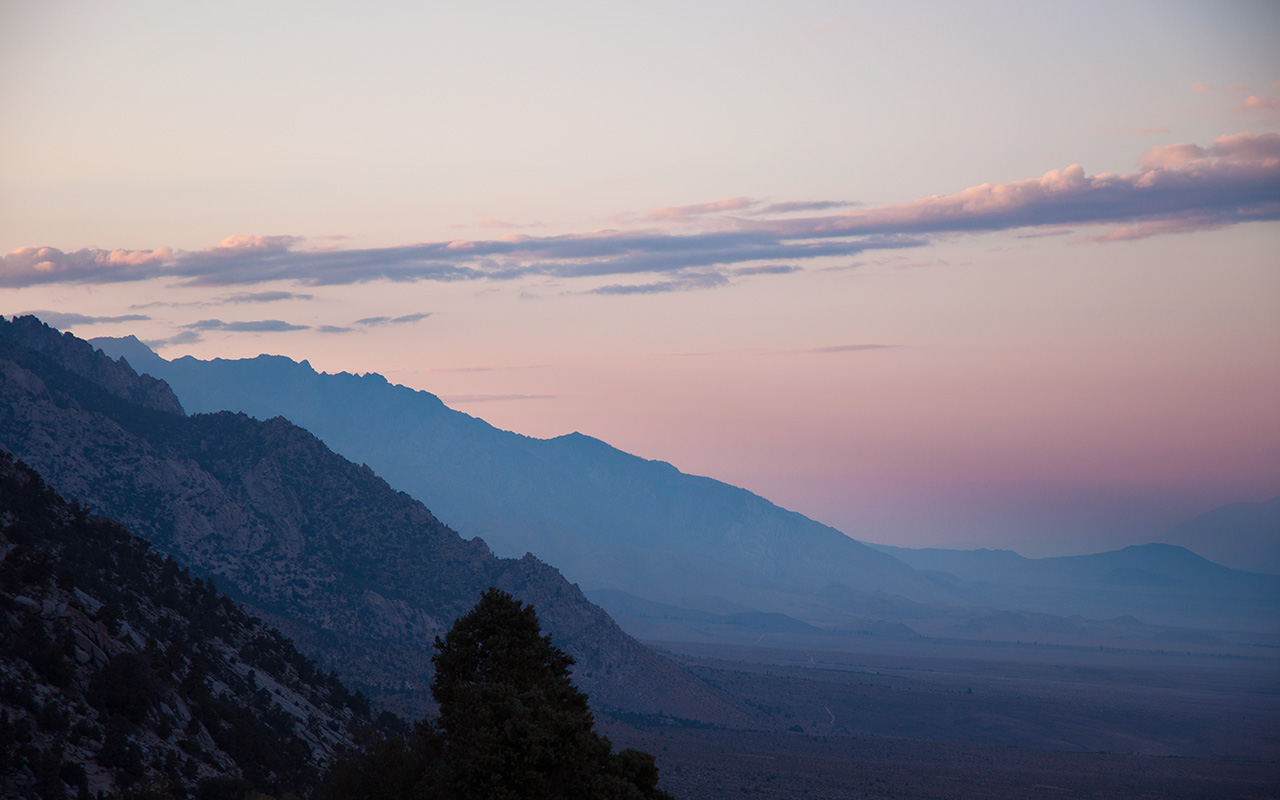
When I close my eyes...I see granite. I am lying in bed in a motel room in Mojave, California, trying to get some sleep. But the images of the past 24 hours are burned into my mind.
The sense of vertigo grows so intense I must open my eyes, stare into the darkness, listen to the a/c tick. A train rumbles past in the distance. In this calm, quiet, and very, very flat place, only these images of rock and space flashing in my mind are present to remind me of today's extraordinary adventure.
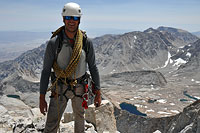
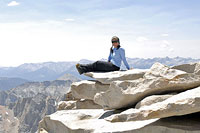
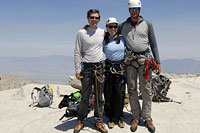
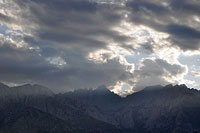
Working with Kurt Wedberg and the Sierra Mountaineering International team, I must say, was a great pleasure.
Safety is a primary issue for me. On this trip, I not only got to climb Mount Whitney's incredible east face, I did so with full confidence that I was in expert hands.
Much thanks are also in order to Eileen, who proved to be a perfect partner to share this adventure with.
It was easy, climbing with Kurt, to forget he was our guide. As a guide he has an easy, natural style that made for an enjoyable group dynamic.
While he was always on the job, watching out for us, Kurt's influence was seamless and subtle, adding just enough help to keep us all safe and sound when we needed it, and giving us the space to do things at our pace whenever possible.
One of the things I find unique about Kurt is his involvement in the online climbing community.
He is an active participant at the Whitney Portal Store message boards, as well as on Summit Post, where he offers advice, information on current conditions, and often just good old fashioned encouragement.
As for his company, and the other guides who work for him, Kurt notes, "People want to feel like they're a part of the process." He makes a point to tell his guides to approach each trip, "Like you want to make a friend." I felt that right away...and I did.
Let me also call attention to Kurt's excellent photography, without which this article would not have been the same. Kurt's photos appear as the lead on the first page (those are his feet, not mine!), and also the lead on the Tower Traverse and Grand Staircase pages. Additionally, if you see a shot of me anywhere here, Kurt likely took those as well, all with his trusty Nikon D200.
I hope in writing this account I haven't left out the fact that I was often scared out of my wits, and tired, and sore, and more than once swearing I'd never try anything crazy like this again. It wasn't easy, and it absolutely pushed me outside of my comfort zone. But you know what? I did it, and in the end I had a heck of a lot of fun. It's good to push your limits now and then—especially when you've got someone you trust looking out for you.
SierraDescents extends a hearty thank you! to Kurt Wedberg and Sierra Mountaineering International for making this a safe and successful climb. Sierra Mountaineering International is one of the oldest guiding companies in Bishop, and offers a comprehensive range of climbs and courses in the Sierra, as well as trips all over the world. To get started on you own SMI adventure, contact Kurt via his website, or give him a call at (760) 872-4929 and tell him I said hello.